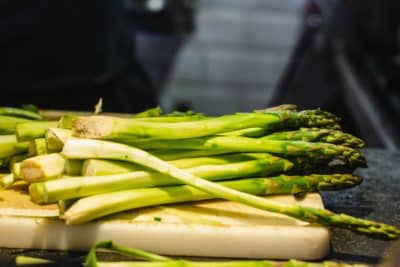Spring Green Pasta

Olives – An Excellent Source of Fatty Acids
Olives are well known as a signature ingredient in Mediterranean dishes. But did you know that the olive is actually a fruit? And it is a fruit that we do not consume in their raw form but only after they’ve been cured. Olives are quite remarkable: they grow on trees that are hardy and resistant to droughts, diseases, and fires. That is why they are known for their longevity. Take a look at the photo below – it is possibly the oldest olive tree in the world, on Crete – estimated to be 3,000 years old!
Out of the dozens of fruits and vegetables, the olive contains the highest percentage of fatty acids at 20 percent, which tops even the avocado and soybean (at 17 percent). It is the olive’s higher fat content that gives it a bad reputation for some people. However, the overall health benefits overshadow any potential issues from the higher fat content. AND, more importantly, olives contain one of the healthiest fatty acids- monounsaturated fatty acids (MUFA), and these are needed for proper cellular structure of our cell membranes in cell membrane phospholipids. Oleic acid is also an energy source on the cellular level (called ATP). So rather than worry about the fat content, appreciate the support MUFA provides.
Amazingly, recent research has revealed that eating olives or olive oil as a good fat instead of other fats can decrease total cholesterol levels and LDL cholesterol (the harmful type) levels. Furthermore, choosing olive oil over other oils or saturated animal fats can help to prevent oxidation of cholesterol, which can form plaque that can lead to heart attacks or even strokes.
Olives, and especially olive oil (also featured in this yummy pasta), may also be beneficial in helping to prevent and treat conditions such as asthma, arthritis, and cancer (specifically breast cancer). Olive oil is considered to be a “healthy oil” which helps to lower systemic inflammation. It has also been seen as very beneficial for diabetics by helping to better control blood sugar and lower triglyceride levels.
Olives and olive oil have contributed to longevity of many cultures over hundreds of years. I pretty much only use this oil in my kitchen. Just make sure your olive oil is pure and your olives are in real brine (water, salt) and have not been pasteurized. Unfortunately, olive oil in the US sometimes contains other oils. Did you know? If you would like to see research, results, and what to do to test your olive oil for purity, I wrote about all that in another blog.

Photo by Nicole Harris on Unsplash
Artichokes – A Flavorful Low-Calorie Food
This recipe also offers a healthy heaping of artichoke hearts. The artichoke is rich in fiber, magnesium, manganese, folate, chromium, potassium, iron, calcium, and vitamin C. It’s low in calories because most of its carbohydrate is inulin, a prebiotic starch that feeds the beneficial gut bacteria but is not used for energy by the body, so it has no effect on blood sugar. For more benefits of the amazing artichoke, see our Garlic and Herb Marinated Artichokes post. Artichokes are available frozen at Trader Joe’s, but should be rinsed first.

Photo by Louis Hansel on Unsplash
Asparagus – A Super Food!
Another springtime favorite, harvested in April, May, and June, is asparagus. Asparagus is rich in folic acid, which helps the body protect itself from lung cancer, uterine cancer, and colon cancer. It also contains a powerful antioxidant glutathione, which eliminates cancer-causing free radicals and facilitates the daily detoxification. Read more about this cancer-fighting superfood in our Asparagus and Mushroom Salad recipe post.
Ingredients
- 6 artichoke hearts
- 6 thin asparagus spears, cut into 1-inch pieces
- 8 ounces brown rice pasta
- 1 tablespoon extra-virgin olive oil
- 1/3 cup chopped scallions
- 2 cloves of garlic, chopped
- 12 black olives, pitted
- ½ cup green peas
- 1 teaspoon chopped parsley
- 1 teaspoon dill
- 1 teaspoon thyme
- Real Salt
- Black pepper
Instructions
- Bring a large saucepan of water to a boil, and add the asparagus. Simmer for 3 minutes, then drain, keeping the liquid, and set aside. Bring a large pot of fresh water to a boil. Add the pasta and cook until tender. Meanwhile, heat the olive oil in a saucepan. Saute the scallions and garlic for 3 minutes. Stir in the olives, peas, dill, thyme, parsley, artichoke hearts and asparagus, and 1/3 cup of the reserved liquid. Stir well and cook until just heated through. Transfer to a serving bowl and set aside. Drain the pasta and toss it into a bowl with the sauce until it is well-coated. Season with salt and pepper to taste.
LEAVE A COMMENT
If you want to transform your life, if you want health and wellness, if you want peace of mind, there isn’t a better investment than working with Kasia.~ Beth























2 Comments
Posted on February 17, 2020 at 8:20 AM by LUPE PELLETIER
LOVE THIS RECIPE! However, I substituted the brown rice pasta for almond flour pasta by Cappello’s it’s grain-free and gluten-free it does list tapioca and xanthan gum however. For me, since I have Celiac I found that corn and rice don’t settle well for me either. I have the occasional homemade corn bread and the occasional rice pasta at restaurants. I read that it’s common for Celiacs to avoid corn and rice because like wheat, they are from the grass family. Otherwise I made this awesome recipe and we love it.
Posted on February 24, 2020 at 10:26 PM by Kasia Kines
Lupe, thank you for sharing your experiments with recipes in a few of our recipes. Some great ideas. One thing that comes to mind is that in celiac, the reason people may have an issue with corn, rice, oats or even millet, is “cross-reactivity” – this will vary in people with celiac- one person can be sensitive just to rice or to millet. Or two of the listed grains. It looks like you have found out where your safe area with foods is. Dr. K